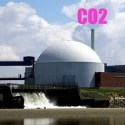 Nuclear energy is often presented as a solution for the greenhouse effect. The emissions of carbon (CO2) would drastically decrease by using nuclear power plants. There are two arguments opposing this view. Firstly, in the current Dutch situation the reduction of CO2–emissions will be much less as often claimed, if compared with a highly efficient combined heat and power (CHP) plant. This power station almost halves the decrease in CO2–emissions gained by nuclear energy. And, secondly, nuclear energy it selves contributes to the greenhouse effect. Due to these two factors, the CO2 gain by nuclear energy decreases even further and will reach zero in the long run.
Nuclear energy is often presented as a solution for the greenhouse effect. The emissions of carbon (CO2) would drastically decrease by using nuclear power plants. There are two arguments opposing this view. Firstly, in the current Dutch situation the reduction of CO2–emissions will be much less as often claimed, if compared with a highly efficient combined heat and power (CHP) plant. This power station almost halves the decrease in CO2–emissions gained by nuclear energy. And, secondly, nuclear energy it selves contributes to the greenhouse effect. Due to these two factors, the CO2 gain by nuclear energy decreases even further and will reach zero in the long run.
Although nuclear power is often heralded as carbon-free and a beneficial replacement for coal-fired power plants, realisation of a new nuclear base load power plant may change the CO2 profile of power generation capacity in the Netherlands in a more sophisticated manner. In particular, a new nuclear power plant may directly compete with highly efficient combined heat and power (CHP) plants, which would significantly reduce the emission reduction often ascribed to nuclear power. In a new research report by CE Delft, an independent research and consultancy organisation, it is stated : “In particular, a new nuclear power plant may directly compete with highly efficient combined heat and power (CHP) plants, which would significantly reduce the emission reduction often ascribed to nuclear power.”
A CHP plant requires natural gas to generate electricity but produces by doing so heat. A nuclear power station only generates electricity, the residual heat is not utilized but ends up in the cooling-water. Suppose that the same amount of electricity from the CHP plant is generated by a nuclear power plant. To produce a same amount of energy (heat), the nuclear power station would need an additional gas-fuelled high-efficiency industrial boiler, which also produces CO2. De CO2 from the nuclear power plant plus boiler is less than that of the CHP, but CE Delft calculates that the net CO2- reduction of the nuclear power plant is approximately 56% of the emissions of the CHP plant . This CHP power station therefore almost halves the CO2 reduction of the nuclear power station.
But there is more: it is likely that a new nuclear reactor in the Netherlands will compete with CHP. Peak demand, is met by flexible (typically gas-fired) plants that have high fuel costs but low fixed costs. Assuming base load demand is met by the cheapest set of base load plants, any new plant that has lower production costs than existing ones has the potential to push the most expensive plant off the base load market. In the Dutch power market the most expensive base load plant is likely to be a CHP plant, with which a new nuclear power plant may compete directly. This means it will replace the relatively environmental friendly CHP plant and not the least environmental friendly: coal powered stations.
However, even this is not the full story. Nuclear energy in it selves also contributes to the greenhouse effect. This has to do with CO2 that is released during the mining and processing of uranium ore, constructing, operating, maintaining and refurbishing of the nuclear power plant, waste management, dismantling of the reactor and construction of a geological repository to isolate the waste. Each process consumes fossil energy, consequently each process, except the production of electricity in the reactor itself, emits CO2: this is called the indirect CO2-emission of nuclear energy.
The mining and processing of uranium ore contributes most to the indirect CO2-emission. At this moment the richer uranium ores, with an average of 0.1 per cent uranium, are mined; meaning that one kilogram of uranium is extracted from 1000 kilograms of rock. The CO2 gain of the nuclear power station compared to a CHP plant, decreases even further by this indirect CO2 emission. In the situation described here, the CO2 gain of a nuclear power plant compared to a CHP plant decreases from 56% to approximately 50%.
There is however a limited amount of richer uranium ore. When, because of for instance the greenhouse effect, more nuclear power stations are built, one would has been forced within 10 to 15 years to mine ores with lower grades of uranium. Then much more rock has to be excavated and processed for the same amount of uranium. Because of that CO2 emission will increase. At an ore grade of 0.02 percent the CO2 gain of a nuclear power plant is about 38% in comparison with the CO2 emissions of a CHP plant . At ores of a lower grade than 0.0086 percent, the nuclear power plant is responsible for more CO2 emissions than when the same amount of electricity would be produced by burning natural gas in the CHP plant and the CO2 gain is zero
Sources
Download this article by Herman Damveld as a PDF, including sources and more information: Nuclear Energy is not CO2-free.
